三年级英语上册The third period(第三课时)
- 格式:doc
- 大小:451.51 KB
- 文档页数:6
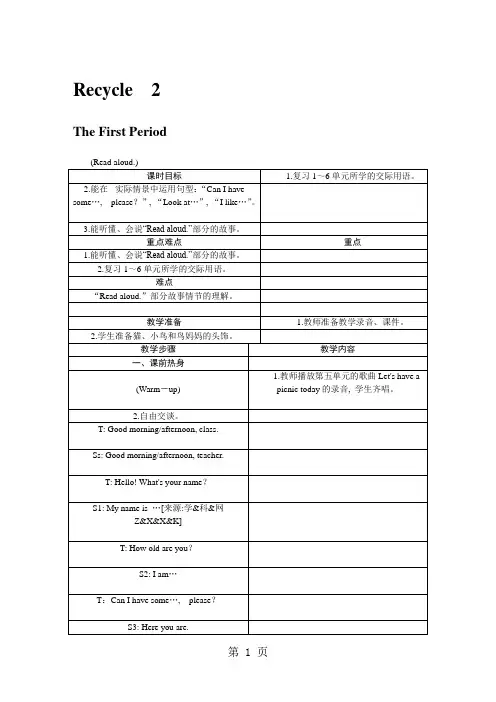
Recycle2The First Period(Read aloud.)课时目标 1.复习1~6单元所学的交际用语。
2.能在实际情景中运用句型:“Can I havesome…, please?”, “Look at…”, “I like…”。
3.能听懂、会说“Read aloud.”部分的故事。
重点难点重点1.能听懂、会说“Read aloud.”部分的故事。
2.复习1~6单元所学的交际用语。
难点“Read aloud.”部分故事情节的理解。
教学准备 1.教师准备教学录音、课件。
2.学生准备猫、小鸟和鸟妈妈的头饰。
教学步骤教学内容一、课前热身(Warm-up) 1.教师播放第五单元的歌曲Let's have a picnic today的录音, 学生齐唱。
2.自由交谈。
T: Good morning/afternoon, class. Ss: Good morning/afternoon, teacher.T: Hello! What's your name?S1: My name is …[来源:学&科&网Z&X&X&K]T: How old are you?S2: I am…T:Can I have some…, please?S3: Here you are.The Second PeriodThe Third PeriodI'm/My name's…Good morning/afternoon.Let's…What's this/that?It's a/an…Can I have some…, please?Here you are.I'd like some…You're welcome.How old are you?I'm…years old.How many…?三、新课呈现dders.G.dow.th.snakes.(Presentation)(1)教师拿出课前准备的骰子, 把本部分的教学挂图贴在黑板上, 并和两位学生演示游戏规则。
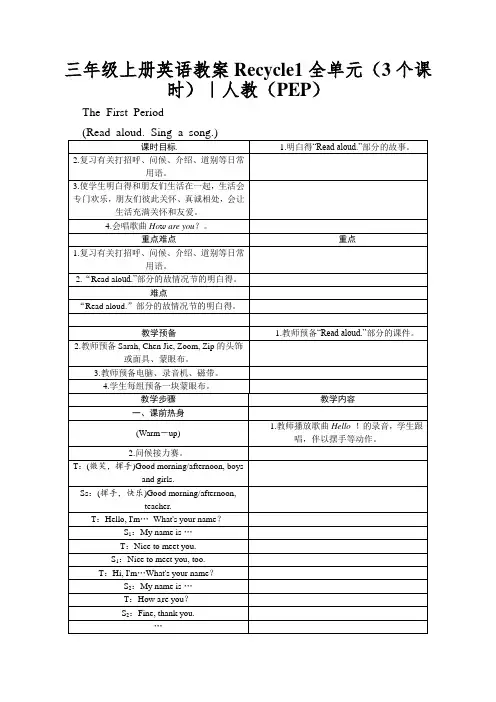
三年级上册英语教案Recycle1全单元(3个课时)|人教(PEP)The First Period(Read aloud. Sing a song.)课时目标 1.明白得“Read aloud.”部分的故事。
2.复习有关打招呼、问候、介绍、道别等日常用语。
3.使学生明白得和朋友们生活在一起,生活会专门欢乐,朋友们彼此关怀、真诚相处,会让生活充满关怀和友爱。
4.会唱歌曲Ho w are you?。
重点难点重点1.复习有关打招呼、问候、介绍、道别等日常用语。
2.“Read alo ud.”部分的故情况节的明白得。
难点“Read aloud.”部分的故情况节的明白得。
教学预备 1.教师预备“Read aloud.”部分的课件。
2.教师预备Sarah, Chen Jie, Zoom, Zip的头饰或面具、蒙眼布。
3.教师预备电脑、录音机、磁带。
4.学生每组预备一块蒙眼布。
教学步骤教学内容一、课前热身(Warm-up) 1.教师播放歌曲Hello!的录音,学生跟唱,伴以摆手等动作。
2.问候接力赛。
T:(微笑,挥手)Good morning/afternoon, boysand girls.Ss:(挥手,快乐)Good morning/afternoon,teacher.T:Hello, I'm…What's your name?S1:My name is …T:Nice to meet you.S1:Nice to meet you, too.T:Hi, I'm…What's your name?S2:My name is …T:How are you?S2:Fine, thank you.…二、课前预习(Preview) 师生依照上面的对话,总结学过的问候语。
(1)当我们想同对方打招呼或问候时,能够说:①Hello./Hi !(什么时刻都能够)②Good morning./Good afternoon./Goodevening.(不同时刻,不同选择)二、课前预习(Preview)(续) ③—How are you?—Fine, thank you./Very well, thanks.(用于熟人之间有一段时刻未见面或是对方躯体欠佳或是较正式地向别人打招呼的场合)④—Nice to meet you.—Nice to meet you, too.(2)当我们想了解对方的姓名或介绍自己时,能够说:What's your name?Your name, please?My name is…/ I'm…(3)当我们介绍自己的伙伴时,能够说:This is…注意:每总结一句话时,能够出示相应的情形图,关心学生明白得。
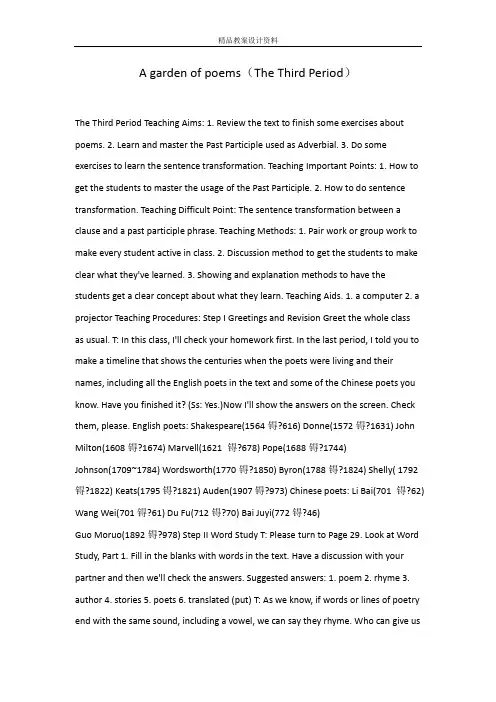
A garden of poems(The Third Period)The Third Period Teaching Aims: 1. Review the text to finish some exercises about poems. 2. Learn and master the Past Participle used as Adverbial. 3. Do some exercises to learn the sentence transformation. Teaching Important Points: 1. How to get the students to master the usage of the Past Participle. 2. How to do sentence transformation. Teaching Difficult Point: The sentence transformation between a clause and a past participle phrase. Teaching Methods: 1. Pair work or group work to make every student active in class. 2. Discussion method to get the students to make clear what they've learned. 3. Showing and explanation methods to have the students get a clear concept about what they learn. Teaching Aids. 1. a computer 2. a projector Teaching Procedures: Step I Greetings and Revision Greet the whole class as usual. T: In this class, I'll check your homework first. In the last period, I told you to make a timeline that shows the centuries when the poets were living and their names, including all the English poets in the text and some of the Chinese poets you know. Have you finished it? (Ss: Yes.)Now I'll show the answers on the screen. Check them, please. English poets: Shakespeare(1564锝?616) Donne(1572锝?1631) John Milton(1608锝?1674) Marvell(1621 锝?678) Pope(1688锝?1744)Johnson(1709~1784) Wordsworth(1770锝?1850) Byron(1788锝?1824) Shelly( 1792锝?1822) Keats(1795锝?1821) Auden(1907锝?973) Chinese poets: Li Bai(701 锝?62) Wang Wei(701锝?61) Du Fu(712锝?70) Bai Juyi(772锝?46)Guo Moruo(1892锝?978) Step II Word Study T: Please turn to Page 29. Look at Word Study, Part 1. Fill in the blanks with words in the text. Have a discussion with your partner and then we'll check the answers. Suggested answers: 1. poem 2. rhyme 3. author 4. stories 5. poets 6. translated (put) T: As we know, if words or lines of poetry end with the same sound, including a vowel, we can say they rhyme. Who can give ussome words that rhyme? SA: I'll try. 鈥渉orse鈥漚nd鈥渕ouse鈥? 鈥渟chool鈥漚nd鈥渇ool鈥? They all rhyme. T锛歍hat's right. (Show the screen.) Now look at the screen. There are two groups of words on the screen. Please read them and match the words that rhyme. Match the words: A: 1. curious 2. image 3.glory 4. absence 5. romantic 6. atmosphere 7. special 8. embrace B: a. audience b. public c. serious d. message e. fear f. social g. base h. story T: (A few minutes later.) Have you finished? Ss: Yes. T: who will give us the answers? SB: They are: l. c;2 d;3 h;4 a;5 b;6 e;7f;8 g. Am I right? T: Sc, do you agree with him? So: Yes, he is right. Step III Grammar (Teacher shows the two sentences on the screen.) The Past Participle used as Adverbial: 1. Once published, his work became famous for the absence of rhyme at the end of each line. 2. No matter how well translated, something of the spirit of the original work is lost. T: Look at the two sentences on the screen. Who can tell us their Chinese meanings? SD The first sentence means:涓€缁忓嚭鐗堬紝浠栫殑浣滃搧灏卞洜涓嶆娂闊佃€岃憲鍚嶃€?The second means: 鍗充娇缈昏瘧寰楀啀濂斤紝涓€缁忕炕璇戯紝鍘熶綔鐨勪竴浜涚簿鍗庡氨娌℃湁浜嗐€?T: Can you think of another way to express these ideas? SE : I'll try. The first sentence can be expressed as: Once it (= his work) was published, his work became famous for the absence of rhyme at the end of each line. The second: No matter how well it (= the original work) is translated, something of the spirit of the original work is lost. T: Quite right. From the sentences we've discussed, we know that if the past participle is used as adverbial, we can change them into the adverbial clauses, which has the same meaning. Are you clear about that? Ss: Yes. T: Now turn to Page 30. Please look at Ex锛?锛嶤omplete each sentence by using the past participle of the right verb锛嶣efore doing that锛寃ho will tell the meanings of the words in the box? SF锛欼'll try. 鈥渂uild鈥漨eans鈥滃缓璁锯€濄€傗€渇righten鈥漨eans鈥滀娇鎯婃亹鈥濓紱鈥渂ite鈥漨eans 鈥滃挰鈥濓紱鈥渇ollow鈥漨eans鈥滆窡闅忊€濓紱鈥渟hoot鈥?means ee鈥漨eans鈥滅湅瑙佲€濓紱鈥済ive鈥漨eans鈥滅粰鈥濓紝鈥渆xamine鈥漨eans nd鈥渟uppose鈥漨eans T锛歏ery well锛嶯ow have a discussion in pairs and give us their proper forms锛?While doing this锛宼alk about the meaning o{each sentence锛嶰K? (Students have a discussion and teacher goes among the class and answers the questions the students ask锛? Suggested answers锛?1锛嶧rightened 2锛嶨iven 3锛巉ollowed 4锛巈xamined 5. Built 6锛巗een 7锛巄itten 8锛巗hot 9. supposed Step 鈪?Practice (Teacher SHOWS the sentences on the screen锛? 1.The castle, burned down in 1943锛寃as never built锛?2锛嶪f left alone on a deserted island锛寃hat would you do to survive? T锛歀ook at t灞眛wo sentences on the screen锛嶦ach of the sentences has a past participle锛嶩ave a discussion about them and decide their functions锛?(After a few minutes鈥?discussion锛? Sa锛欼n the first sentence the past participle phrase鈥渂urned down in 1943鈥漣s used as attribute锛巑odifying the noun 鈥渃astle鈥濓紟The meaning f the whole sentence is锛?943у煄鍫★紟鍐嶄篃娌℃湁閲嶅缓銆?Sb锛欼n the second sentence銆傗€?eft alone on a deserted island鈥漣s used as adverbial锛?expressing condition锛?T锛歐hat is the meaning of it? Sb瀛樹笅鍘汇€備綘浼氭€庝箞鍔炲憿? T锛欸ood锛嶯ow锛宭ook at the sentences on the screen and the function of each past participle phrase锛嶻ou can do it in pairs or groups锛?Tell the function of the Past Participle in the following sentences锛?1.The room锛宑onnected to the rest of the house by a long passage 锛寃as completely empty锛?2锛嶤onnected to the rest of the house by a long passage锛宼he room seems very quiet銆?3锛嶧olded in his pocket锛宼he letter wasn't found until twenty years later锛?4. He was walking around with the letter folded in his pocket. (A few minutes later锛? T锛欰re you prepared? (Ss锛歒es銆? Please tell us the function of each past participle and the meaning of each sentence 锛?Sc锛欼n the first sentence锛宨t is used as attribute锛嶵he meaning of thesentence is鏂圭浉杩炵殑灞嬪瓙閲岄潰绌烘棤涓€鐗┿€?Sd锛欼n the second sentence, the past participle phrase is used as adverbial锛?expressing the cause锛嶵he sentence means鐨勫湴鏂圭浉杩炴帴鐨勶紝鎵€浠ュ畠寰堝畨闈欍€?Suggested answers锛?3锛嶢dverbial?锛嶢ttribute淇°€?Step V Consolidation T: Look at the example on Page 30. Here are two sentences. They both have the same meaning, but their adverbials are expressed in the different ways. Study the example and then rewrite the sentences on Page 31, using a clause to substitute the past participle phrase. Suggested answers: 1. When he was asked what had happened, he told us about it. 2. As he was well known for his expert advice, he received many invitations to give lectures. 3. If we were given more time, we would be able to do the work much better. 4. Once it was translated into Chinese, the book became very popular among Chinese teenagers. 5. As she was deeply interested in medicine, she decided to become a doctor. 6. Though she was left alone at home, Sam did not feel afraid at all. Step VI Summary and Homework T: In this class, we've talked about rhyme and the use of the past participle. The past participle of the verb can be used as adverbial and attribute, such as, 鈥淥ne鈥︹€?鈥淭he castle 鈥︹€? We also know that the past participle can be expressed with a clause, such as鈥淯nited鈥︹€?Teacher writes the sentences on the blackboard. ) Today's homework: Join each pair of sentences to form one sentence, using the past participle. That's all for today. Class is over. Join the two sentences in each group. 1. Mary was shocked at what Jack had said. She didn't know what to say at first. 2. The mirror was broken. The mirror was lying on the ground. 3. l went into the dark room. 1 was followed by my best friend. 4: The park is the most beautiful place in the city. It was destroyed by thestorm last Sunday. 5. The dog barked at us. The dog was tied to a pole by the door. 6. They were sad to see a sea of flowers. The flowers were covered by the heavy snow.7. The scientist is well known for his knowledge. The scientist is able to help the workers to get out of their difficulty. 8. The coins were collected by my cousin. The coins were made in Tang Dynasty. Step VII The Design of the Writing on the Blackboard Unit 4 A garden of poems The Third Period Grammar: The Past Participle used as Adverbial1. 1. Once published, his work became famous for the absence of rhyme at the end of each line. No matter how well translated, something of the spirit of the original work is lost. 2. The castle, burned down in 1943, was never built. If left alone on a deserted island, what would you do to survive? 3. United, we stand 锛沝ivided, we fall. If we are united, we will fall锛沬f we are divided, we will fall. Step VIII Record after Teaching ______________________________________________________ ___________________________。
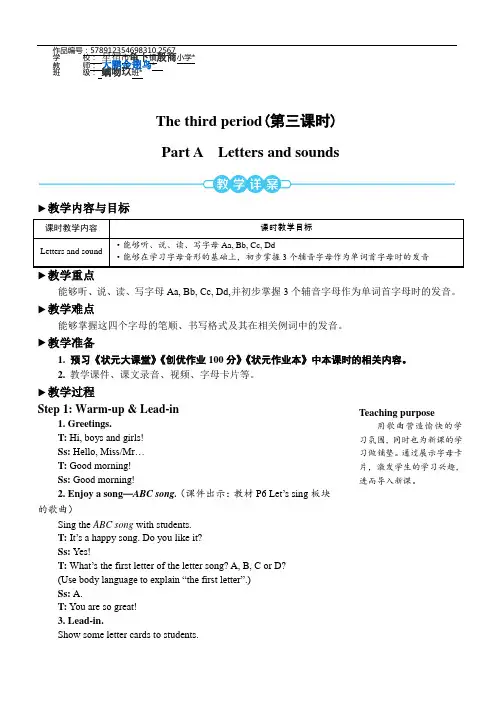
作品编号:578912354698310.2567 学校:星宿市龟卜镇殷商小学*教师:大鹏金翅鸟*班级:螭吻玖班*The third period(第三课时)Part A Letters and sounds▶教学内容与目标课时教学内容课时教学目标Letters and sound ·能够听、说、读、写字母Aa, Bb, Cc, Dd·能够在学习字母音形的基础上,初步掌握3个辅音字母作为单词首字母时的发音▶能够听、说、读、写字母Aa, Bb, Cc, Dd,并初步掌握3个辅音字母作为单词首字母时的发音。
▶教学难点能够掌握这四个字母的笔顺、书写格式及其在相关例词中的发音。
▶教学准备1. 预习《状元大课堂》《创优作业100分》《状元作业本》中本课时的相关内容。
2.教学课件、课文录音、视频、字母卡片等。
▶教学过程Step 1: Warm-up & Lead-in1. Greetings.T: Hi, boys and girls!Ss:Hello, Miss/Mr…T: Good morning!Ss: Good morning!2. Enjoy a song—ABC song.(课件出示:教材P6 Let’s sing板块的歌曲)Sing the ABC song with students.T: It’s a happy song. Do you like it?Ss: Yes!T: What’s the first letter of the letter song? A, B, C or D?(Use body language to explain “the first letter”.)Ss: A.T: You are so great!3. Lead-in.Show some letter cards to students. Teaching purpose用歌曲营造愉快的学习氛围,同时也为新课的学习做铺垫。

作品编号:GLK520321119875425963854145698357学校:黄莺读市仙鹤镇喜鹊小学*教师:悟性中*班级:凤翔2班*The third period(第三课时)Part B Let’s try & Let’s talk▶教学内容与目标课时教学内容课时教学目标Let’s try ·能够读懂题目要求,并通过观察Let’s try板块的图片,对听力部分的重点内容进行预测·通过听录音,能够运用基本听力技巧完成Let’s try板块的听力任务Let’s talk ·能够理解对话大意,并能够回答对话下面的问题·能够按照正确的意群及语音、语调朗读对话,并能够在小组中进行角色表演·能够听、说、认读并在情景中恰当运用句型“…must…”和“Don’t…”表达要遵守的交通规则·能够理解情景语言“I must pay attention to the traffic lights!”的大意·通过对话学习了解欧美国家骑自行车的注意事项,了解不同的交通警示标志和这些标志出现的场所▶1.能够理解并在情景中恰当运用句型。
2.能够在情景中运用句型“…must…”和“Don’t…”表达要遵守的交通规则。
▶教学难点能够在情景中恰当运用句型“…must…”和“Don’t…”表达要遵守的交通规则。
▶教学准备1.预习《状元大课堂》《创优作业100分》《状元作业本》中本课时的相关内容。
2.PPT课件、课文音频、视频、教学卡片等。
▶教学过程Step 1: Warm-up & Revision & Lead-in1. Greetings.Teaching purpose歌曲热身,借用歌曲激2. Let’s sing—How do you get there? (出示课件)Students sing the song together.3.Lead-in.(1)Look and say.Show the pictures of ways to go to different places. (课件出示:不同出行方式的图片)Let students look at the pictures and talk about them.A:How do you get to…?B:By taxi/train/bus/ship/plane/subway/bike./On foot./I walk there.(2)Lead-in.T:Wherever we go, we must know and obey the traffic rules. Now, let’s see the pictures and talk about the traffic rules you know.Step 2: Presentation1. Look and guess.(1)Show the picture of “Let’s try” on the PPT. (课件出示:教材P16 Let’s try板块的图片)(2)Let students observe the picture and discuss the questions.T: Look at Picture 1. What are the children doing?Ss: They are crossing the road one by one. (Help students understand the phrase “one by one” with the picture.)Look at Pi cture 2. Lead students to try to say “They are getting on the bus one by one.”T:Mrs Smith and the children are going to the nature park. What does Mrs Smith tell the children to do? Can you guess?Ss:…2.Listen and tick.(1)Show the part of “Let’s try” on the PPT. (课件出示:教材P16 Let\'s try板块的内容) Let students listen and tick.(2)Play the recording of “Let’s try”. (课件出示:教材P16 Let’s try板块的音频)Students try to finish the exercise. Teaching purpose教师引导学生带着问题听录音,整体感知文本,获取有用信息,自然引入文本话题。
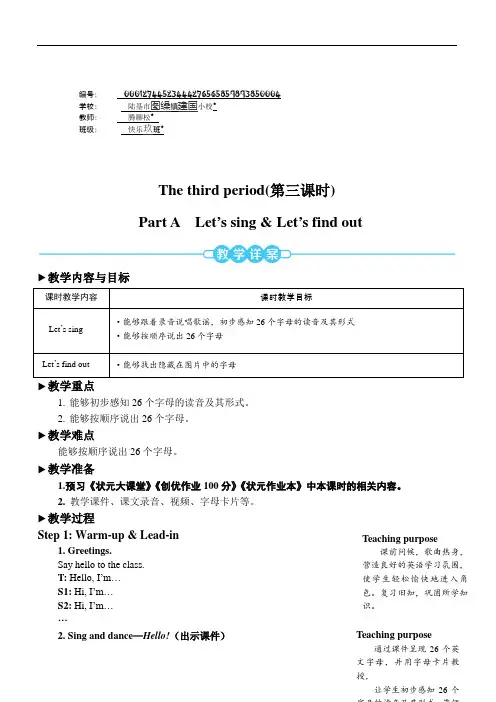
编号:00012744523444276565859893850004学校:陆基市图缲镇建国小校*教师:腾聊松*班级:快乐玖班*The third period(第三课时)Part A Let’s sing & Let’s find out▶教学内容与目标课时教学内容课时教学目标Let’s sing ·能够跟着录音说唱歌谣,初步感知26个字母的读音及其形式·能够按顺序说出26个字母Let’s find out·能够找出隐藏在图片中的字母▶教学重点1.能够初步感知26个字母的读音及其形式。
2.能够按顺序说出26个字母。
▶教学难点能够按顺序说出26个字母。
▶教学准备1.预习《状元大课堂》《创优作业100分》《状元作业本》中本课时的相关内容。
2.教学课件、课文录音、视频、字母卡片等。
▶教学过程Step 1: Warm-up & Lead-in1. Greetings.Say hello to the class.T: Hello, I’m…S1: Hi, I’m…S2: Hi, I’m……2. Sing and dance—Hello!(出示课件)Teaching purpose课前问候,歌曲热身,营造良好的英语学习氛围,使学生轻松愉快地进入角色。
复习旧知,巩固所学知识。
Teaching purpose通过课件呈现26个英3. Revision.T: Look! I have a ruler!Ss: Me too!Step 2: Presentation1. Can you say?T: Boys and girls, we have 26 letters in English. What are they?Look at the screen, please.Show the 26 letters on the PPT. (出示课件)T: Can you read them?Ss: Yes! A, B, C, D…T: Great! OK! Follow me, please. A, A, A!Ss: A, A, A!…Teach the 26 letters one by one by using the letter cards. Let studentsclap their hands and read the letters.2. Drive a train.T: Boys and girls, now let’s play a game.Point to a student and say, “Now the train is coming!A! Go go go!”S1: B!S2: C!…(游戏说明:可从任意字母开始,让学生以“开火车”的方式接龙,也可以“串糖葫芦”的方式,让学生说字母再任意指向其他学生。
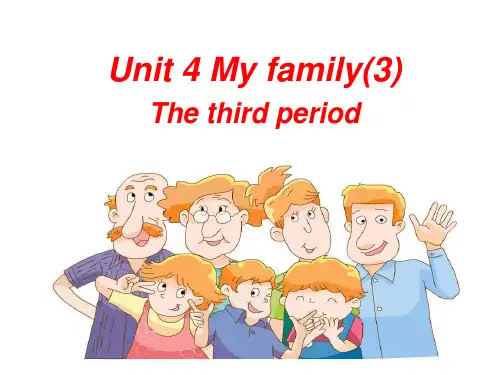
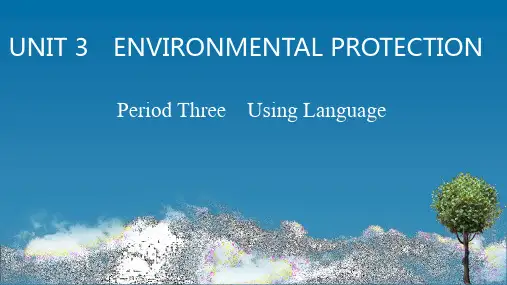
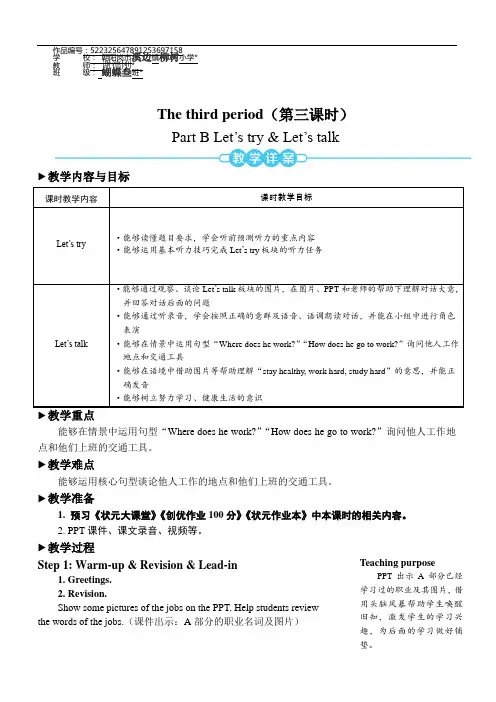
作品编号:522325647891253697158 学校:朝阳岗市溪边镇柳树小学*教师:谢德刚*班级:蝴蝶叁班*The third period(第三课时)Part B Let’s try & Let’s talk ▶教学内容与目标课时教学内容课时教学目标Let’s try ·能够读懂题目要求,学会听前预测听力的重点内容·能够运用基本听力技巧完成Let’s try板块的听力任务Let’s talk ·能够通过观察、谈论Let’s talk板块的图片,在图片、PPT和老师的帮助下理解对话大意,并回答对话后面的问题·能够通过听录音,学会按照正确的意群及语音、语调朗读对话,并能在小组中进行角色表演·能够在情景中运用句型“Where does he work?”“How does he go to work?”询问他人工作地点和交通工具·能够在语境中借助图片等帮助理解“stay healthy, work hard, study hard”的意思,并能正确发音·能够树立努力学习、健康生活的意识▶教学重点能够在情景中运用句型“Where does he work?”“How does he go to work?”询问他人工作地点和他们上班的交通工具。
▶教学难点能够运用核心句型谈论他人工作的地点和他们上班的交通工具。
▶教学准备1. 预习《状元大课堂》《创优作业100分》《状元作业本》中本课时的相关内容。
2. PPT课件、课文录音、视频等。
▶教学过程Step 1: Warm-up & Revision & Lead-in1. Greetings.2. Revision.Show some pictures of the jobs on the PPT. Help students review the words of the jobs.(课件出示:A部分的职业名词及图片)Teaching purposePPT出示A部分已经学习过的职业及其图片,借用头脑风暴帮助学生唤醒旧知,激发学生的学习兴趣,为后面的学习做好铺垫。
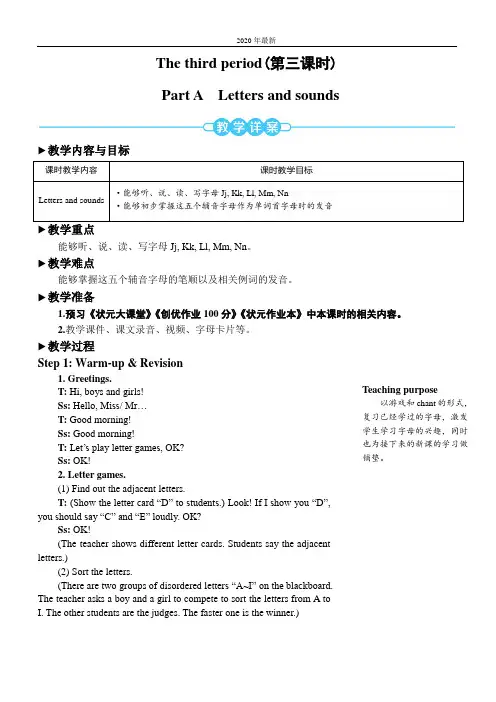
2020年最新The third period(第三课时)Part A Letters and sounds▶教学内容与目标课时教学内容课时教学目标Letters and sounds·能够听、说、读、写字母Jj, Kk, Ll, Mm, Nn·能够初步掌握这五个辅音字母作为单词首字母时的发音▶能够听、说、读、写字母Jj, Kk, Ll, Mm, Nn。
▶教学难点能够掌握这五个辅音字母的笔顺以及相关例词的发音。
▶教学准备1.预习《状元大课堂》《创优作业100分》《状元作业本》中本课时的相关内容。
2.教学课件、课文录音、视频、字母卡片等。
▶教学过程Step 1: Warm-up & Revision1. Greetings.T: Hi, boys and girls!Ss: Hello, Miss/ Mr…T: Good morning!Ss: Good morning!T: Let’s play letter games, OK?Ss: OK!2. Letter games.(1) Find out the adjacent letters.T:(Show the letter card “D” to students.) Look! If I show you “D”,you should say “C” and “E” loudly. OK?Ss: OK!(The teacher shows different letter cards. Students say the adjacentletters.)(2) Sort the letters.(There are two groups of disordered letter s “A~I” on the blackboard.The teacher asks a boy and a girl to compete to sort the letters from A toI. The other students are the judges. The faster one is the winner.)Teaching purpose以游戏和chant的形式,复习已经学过的字母,激发学生学习字母的兴趣,同时也为接下来的新课的学习做铺垫。
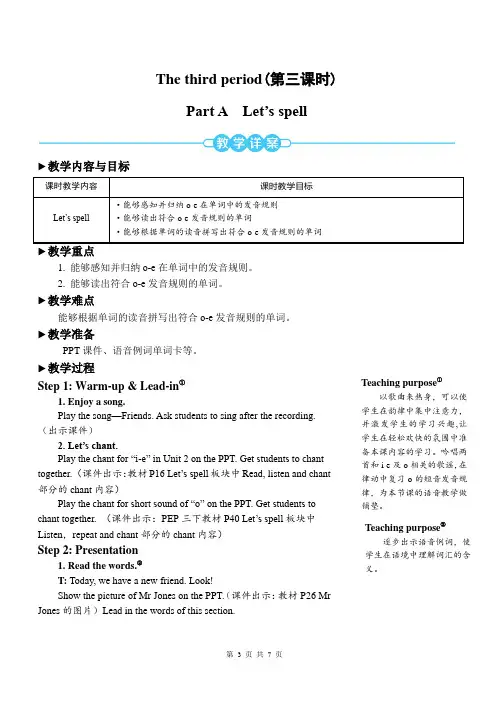
The third period(第三课时)Part A Let’s spell▶教学内容与目标课时教学内容课时教学目标Let’s spell ·能够感知并归纳o-e在单词中的发音规则·能够读出符合o-e发音规则的单词·能够根据单词的读音拼写出符合o-e发音规则的单词▶1. 能够感知并归纳o-e在单词中的发音规则。
2. 能够读出符合o-e发音规则的单词。
▶教学难点能够根据单词的读音拼写出符合o-e发音规则的单词。
▶教学准备PPT课件、语音例词单词卡等。
▶教学过程Step 1: Warm-up & Lead-in①1. Enjoy a song.Play the song—Friends. Ask students to sing after the recording. (出示课件)2. Let’s chant.Play the chant for “i-e” in Unit 2 on the PPT. Get students to chant together. (课件出示:教材P16 Let’s spell板块中Read, listen and chant 部分的chant内容)Play the chant for short sound of “o” on the PPT. Get students to chant together. (课件出示:PEP三下教材P40 Let’s spell板块中Listen,repeat and chant部分的chant内容)Step 2: Presentation1. Read the words.②T: Today, we have a new friend. Look!Show the picture of Mr Jones on the PPT.(课件出示:教材P26 Mr Jones的图片)Lead in the words of this section. Teaching purpose①以歌曲来热身,可以使学生在韵律中集中注意力,并激发学生的学习兴趣,让学生在轻松欢快的氛围中准备本课内容的学习。
作品编号:522325647891253697158 学校:朝阳岗市溪边镇柳树小学*教师:谢德刚*班级:蝴蝶叁班*The third period (第三课时)Part A Let’s spell▶教学内容与目标课时教学内容课时教学目标Let’s spell ·学生能够通过听例词发音,观察例词结构中共有的特征,学习ow在单词中的发音规则·学生能够根据ow的发音规则读出新单词,并能够根据发音拼写出符合规则的单词·学生能够在单线上正确规范地书写句子▶学生能够掌握字母组合ow在单词中的发音,能够读准Let’s spell板块的例词,并完成本部分的练习。
▶教学难点学生能够自主发现并总结ow的发音规则,并根据发音规则读出新单词。
▶教学准备1.预习《状元大课堂》《创优作业100分》《状元作业本》中本课时的相关内容。
2. PPT课件、课文录音、视频、单词卡片等。
▶教学过程Step 1: Warm-up & Lead-in1. Greetings.2. Lead-in.Show some pictures of food and drinks and ask students to practice the key sentence patterns. (出示课件)T:What would you like to eat/drink? Ss:…(课件出示:一头奶牛、一些鲜花和一些青草的图片)T:What would the cow like to eat, flowers or grass? Ss:…Step 2: Presentation1.Look and find.Show a picture of a cow with the word “cow” on the PPT and ask, “What’s this?” (出示课件)Then show a picture of some flowers with the word “flower” and say, “Wow! There are some flowers. How beautiful!”(出示课件)Teaching purpose通过师生问答活动复习旧知,活跃课堂气氛。
作品编号:0115230988859532558954500001学校:秘强市景秀镇赛班家屯小学*教师:丽景春*班级:凤凰队参班*The third period(第三课时)Part A Letters and sounds▶教学内容与目标课时教学内容课时教学目标Letters and sounds ·能够听、说、读、写字母Oo,Pp,Qq,Rr,Ss,Tt,并在学习字母音、形的基础上,初步掌握元音字母Oo和五个辅音字母作为单词首字母时的发音▶1. 能够听、说、读、写字母Oo,Pp,Qq,Rr,Ss,Tt。
2. 能够初步掌握元音字母Oo和五个辅音字母作为单词首字母时的发音。
▶教学难点能够掌握字母的笔顺以及相关例词的发音。
▶教学准备1.预习《状元大课堂》《创优作业100分》《状元作业本》中本课时的相关内容。
2.教学课件、课文录音、视频、字母卡片等。
▶教学过程Step 1: Warm-up & Revision1. Greetings.2. Sing the song—ABC song. (出示课件)3. Revision.T: Now, let’s chant and do some actions.Teaching purpose通过歌曲和TPR活动,激发学生的学习兴趣,复习字母A到N,为新授内容做铺垫。
Step 2: Presentation1. Teach the letters.Ss: Oo!Let students read the letter “Oo” after the recording.(出示课件)T: Can you find something that looks like “Oo” in your daily life?Ss:…(课件出示:呼啦圈、钥匙扣、轮胎、盘子、西瓜、足球、篮球等图片,并在这些图片上标出Oo)Write down the letter “Oo” on the blackboard. Let students show their fingers and write after the teacher. Let them pay attention to the capital letter and the lowercase letter.T: “Oo” has many friends. Who are they?Lead in the letters “Pp,Qq,Rr,Ss,Tt” in the same way.(出示课件)2. Match the letters.Disorder the capital letter cards and put them up on the blackboard.T: Who can help me put up the lowercase letter cards under the right capital letter cards?Invite some students to the front and finish the matching task.3. Teach the example words.Show an orange and a box on the PPT. Teaching purpose强化学生对字母大小写的区分和记忆。
Teaching purpose利用课件呈现图片,将单个的单词串联起来,赋予Teaching purpose以猜谜的形式引出字母Oo,同时将字母拟人化,让学习变得生动、有趣。
引导学生联想生活中像字母的物品,培养学生的观察和联想能力,贴近学生的生活实际。
提醒学生注意区分字母的大小写,注重对学生学习方法的指导。
Let students listen to the recording and repeat. (出示课件)T:What similarity can you find between “orange” and “on”?Ss: …T: Excellent! They ha ve the same first letter “o”. What’s the sound?Let students clap their hands and chant: Oo, Oo, Oo, /ɒ/, /ɒ/, /ɒ/. /ɒ/, /ɒ/, orange. /ɒ/, /ɒ/, on.Show the pictures on the PPT and teach the other example words in the same way. (出示课件)4. Listen, repeat and chant.Play the video of the chant. (课件出示:教材P50 Listen, repeat and chant的视频) Let students chant after the video. Lead students to clap their hands and do the actions.Let students practice in groups and show it in class. Give the prize to the best group.Step 3: Practice1. Listen and circle.Let students look at the pictures and letters carefully. Lead them to predict the listening content and describe the pictures. Then ask students to read all the letters and say the words according to the pictures. Let students pay attention to the pronunciation of the letters. Play the recording, and let students listen and circle. (课件出示:教材P50 Listen and circle 的音频) Check the answers on the PPT. (课件出示:教材P50 Listen and circle的答案)2. Can you guess?Let students guess the animals and fill in the blanks. (课件出示:一些动物被云朵遮住,只露出部分身体的图片和首字母设空的相应单词)Step 4: Consolidation & Extension1. Write and say.Teaching purpose让学生打着节拍chant,增强趣味性的同时还能培养学生的节奏感。
最后,分组排练并在班级内竞赛展示,将一般的练习特殊化,更好地激发学生的学习热情,加强对字母的掌握。
Teaching purpose在做听力练习之前,预留时间让学生对图片加以熟悉,注重对学生学习方法的指导。
让学生根据图片和提示猜出动物并补全单词,增加一定难度,激发学生的挑战欲望。
Teaching purpose指导学生注意字母在四线三格内的笔顺。
通过传球游戏,提高学生的学习热情,活跃课堂气氛,在游戏中培Play the cartoon. (课件出示:教材P50 Write and say的视频) Letstudents watch it carefully and pay attention to the stroke order, thenwrite down the letters in their books.(Tips:指导学生书写字母时,字母的笔顺、占格情况以及难点字母如Pp, Qq, Rr需多加强调。
)2. Pass the ball.(游戏说明:教师将学生分成A、B两组,先由A组的一名学生说一个字母o,再由B组的一名学生以最快的速度说出以o开头的单词,如:orange。
然后由B组的一名学生说下一个字母p,再由A组的一名学生说出以p开头的单词,如:pig。
依次循环,轮流说字母和单词,积分多的那一组将获得奖励。
)▶板书设计▶作业设计1. Copy the letters five times.2. Sing the chant to your family.3. Do the exercises. (见“状元成才路”系列丛书《创优作业100分》或《状元作业本》对应课时作业)▶教学反思1. 教学始终围绕学生的生活实际展开,从生活中寻找和发现字母,降低学生的学习难度,便于学生掌握新知。
2. 突出学生的主体地位,教师以引导为主,尽可能给学生足够的空间,如让他们通过听例词、读例词、学例词总结字母在单词中作为首字母时的发音规律。
3. 运用TPR教学法,猜谜、传球游戏等多种活动形式调动学生的学习积极性,为学生创造良好的英语学习氛围。
4. 充分发挥多媒体资源优势,使得例词的教学富有故事性和情景性,吸引学生注意力,激发学生的学习兴趣。
▶Teaching Contents & Teaching AimsLetters and sounds·Be able to listen, speak, read and write the letters “Oo, Pp, Qq, Rr, Ss, Tt”and master the pronunciation of the letters as the first letter in words.▶Teaching Priorities·Be able to listen, speak, read and write the letters “Oo, Pp, Qq, Rr, Ss, Tt”.·Be able to master the pronunciation of the letters“Oo, Pp, Qq, Rr, Ss, Tt”as the first letterin words.▶Teaching Difficulties·Be able to master the stroke order of the letters and the pronunciation of the example words.▶Teaching ProceduresTeachingStagesTeacher’ s Activities Students’ Activities Teaching PurposesWarm-up& Revision 1. Greetings.2. Sing the song—ABC song.3. Revision.1. Greetings.2. Sing the ABC song.3. Chant and do the actionswith the teacher.Cultivate students’interest in learning.Help students reviewthe letters that theyhave learnt and preparefor the new lesson.Presentation 1. Teach the letters.Let students guess a riddleand teach the letter “Oo”.Play the recording of “Oo”.Let students pay attention tothe capital letter and thelowercase letter. Teach theletters “Pp, Qq, Rr, Ss, Tt” inthe same way.Guess a riddle. Learn thenew letters. Read theletters after the recording.Then find things that looklike the letters in theirdaily life. Write theletters with fingers afterthe teacher.Lead in the lettersproperly. Cultivatestudents’ interest inlearning and theirability of observationand association.Remind students todistinguish between thecapital letters and thelowercase letters. Payattention to theguidance on theirlearning methods.2. Match the letters.Disorder the capital lettercards and put them up on theblackboard.Try to match the capitalletters to the lowercaseletters.Strengthen students’distinction and memoryof the letters.3. Teach the example words.Show some pictures on thePPT and teach the examplewords. Let students clap theirhands and chant together.Learn the example wordsand chant with the teacher.Let students learn theexample words insentences, so that theycan understand andmaster the words better.4. Listen, repeat and chant.Play the video of the chant.Watch the video and chantafter it. Clap hands and doLet students sing thechant in rhythm.(续表)。